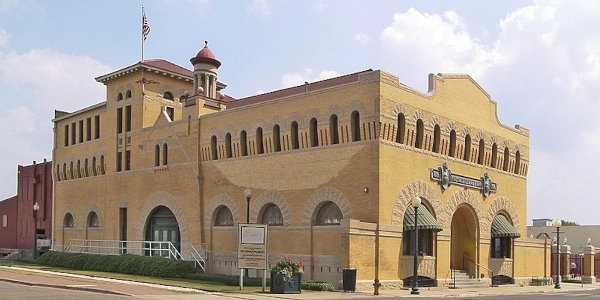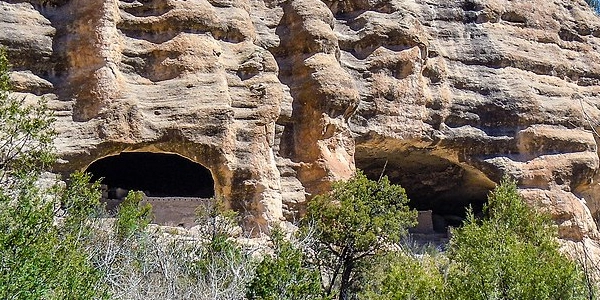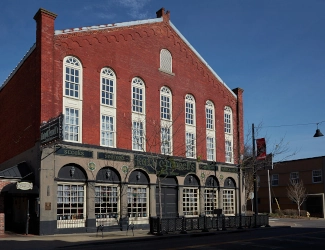
Image above: Katey O'Farrell's Public House Tavern, 2020, Carol M. Highsmith. Courtesy Library of Congress.
Spotlight on Lesser Known History
Cape Girardeau, Missouri
America's Best History Spotlight
On this page we're going to Spotlight the lesser known historic sites and attractions that dot the history landscape across the USA and are worth a visit if you're in their area. And while they may be lesser known, some are very unique, and will be that rare find. You'll be, at times, on the ground floor, or maybe even know something others don't. It'll be fun. Visit them.

Cape Girardeau, Missouri
This month's focus seems a bit odd as its history is multi-faceted and some would say might not rise to known status because each is a little small, but Cape Girardeau, Missouri has an interesting founding in the western expansion days, a college in its midst, Southeast Missouri State University, on the grounds of the former St. Vincent's Seminary, a small Civil War battle, and a meteorite, and that's some unique history collection. Add in twenty-four historic murals on the levee wall protecting the city from the Mississippi River and some historic homes, and you've got yourself a great day of finding gems in this city of forty thousand people. Photo above: One of the twenty-four Mississippi Tales murals painted by Thomas Melvin, this one depicting the Louisiana Purchase, 2020, photo by Carol M. Highsmith. Courtesy Library of Congress.
Sponsor this page. Your banner or text ad can fill the space above.
Click here to Sponsor the page and how to reserve your ad.
Info, What's There Now, History Nearby

Cape Girardeau, Missouri
Namesake to the first man who established a trading post on the river there, Jean Baptiste de Girardot, in 1733. He was a French soldier stationed in the French Colony of La Louisiane. It became settled after the Spanish acquired the territory in 1764 after the Seven Years War, although it took until 1793 for them to do that, with land grants to Louis Lorimier and the Black Bob Band of the Shawnee, who had migrated west of the Mississippi.
The town became incorporated in 1808, the city in 1843. With the advent of the steamboat, it became the largest port between St. Louis and Memphis. Only three years after rising to city status, Cape Girardeau was hit by a meteor on August 14, 1846. It has been classified as an H6 Meteor. So what does that mean? Well, the Meteorite Society says it was a high-iron chondrite with homogenized mineral composition. It was 2.3kg big and heard hitting earth southeast of the city with a loud bang, coordinates 37 degrees 16N. 89 degrees 35' W. Twenty-three others have fallen in Missouri. If you visit, just watch out for falling rocks.
Cape Girardeau moved forward, with the tide of Civil War coming to the area, Union controlled, on April 26, 1863.
Image above: Fort D, one of four Civil War forts built in Cape Girardeau, 2020, Carol M. Highsmith. Courtesy Library of Congress. Below: Glenn House, 2020, Carol M. Highsmith. Courtesy Library of Congress.
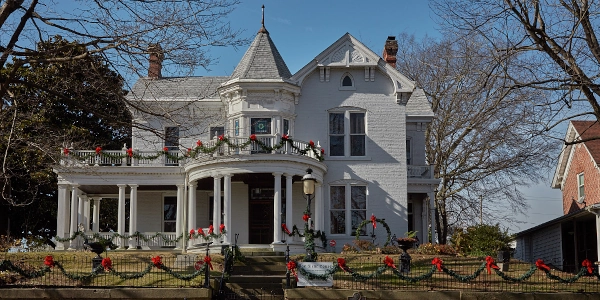
Where Is It
Cape Girardeau, Missouri is located on the Mississippi River about one hundred and fifteen miles south of St. Louis off Route I-55. The Visitor Center is located at 220 North Fountain Street, Cape Girardeau, MO 63701-5636.
What is There Now
Cape Girardeau
The historic Mississippi River city of nearly forty thousand south of St. Louis is not a single attraction location. It is a mixture of museums, colleges, murals, and parks. Check at the local tourist bureau for a map to the attractions you wish to see. Some might be coming to college there; others to hear of the Victorian tales at Glenn House or the Missouri and Mississippi River tales along the waterfront.
When Open and How Much
Variety of opening days and times. Check with the individual sites around town for their schedules and fees.
Fees subject to change.
Websites
Cape Girardeau Visitor Center
City of Cape Girardeau
Glenn House
Katy O'Ferrell's Irish Pub
Southeast Missouri State University
History Nearby
It's unique location puts you in access to a variety of Missouri sites, including St. Louis, one hundred miles north, and more, including site in northern Arkansas. For Civil War fans, don't miss the Wilson's Creek battlefield, Pea Ridge, or the Battle of Prairie Grove. For more nature bound fans, there's the Ozark National Scenic River.
-
St. Louis Gateway
-
Wilson's Creek
-
Pea Ridge Battlefield
-
Prairie Grove
-
Ozark NSR
-
George Washington
Carver NM -
Fort Osage
Buy Chronology

Great Book for the History Fan with Fifty Short Essays Telling the Story of American History.
Photos, History, and More Spotlights
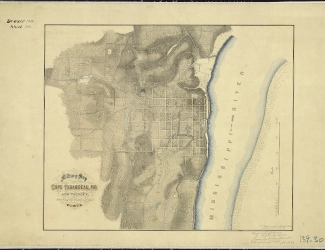
Battle of Cape Girardeau
On April 26, 1863, a small battle ensued during the second raid of Confederate General John S. Marmaduke into southeast Missouri from northwest Arkansas. He brought his five thousand man division north with eight to ten pieces of artillery, starting eight days earlier, through Bloomfield, which had been abandoned by Union General John McNeil for the four forts at Cape Girardeau. One third of the Confederate force arrived near the forts on April 25, and demanded that McNeil surrender. He refused, confident that his fortifications could be held by the men he had.
The forts had been constructed in 1861 under the orders of General U.S. Grant. Fort A would guard the city from Confederate gunboats coming from the north. Fort B was positioned on a hill where Southwest Missouri State now stands. Fort C guarded approaches on Bloomfield Road. Fort D was on a river bluff south of town, the largest to defend against a river attack from the south. It is the only one standing today, but did not take part in the Battle of Cape Girardeau.
With the Confederates approaching from the west, McNeil brought artillery from Forts A and D, and most of his four thousand men, to the area of Forts B and C. General Marmaduke's division arrived in full by early April 26; Colony Shelby on the left, Bambridge in the center, and Carter on the right. The attack began at 10:00 a.m. with Confederate cavalry under Shelby making significant advances; however, the cannons from the forts (B and C) shot heavy fire into the Confederate lines, causing their withdraw about 2:00 p.m.
While the battle was short with limited casualties, and inconclusive as far as military action, it's aftermath became a strategic Union win, forcing Marmaduke to retreat back to Arkansas.
Photo above: Map of Cape Girardeau during the Civil War, including the placement of four small Union forts to defend it, 1865, War Department, Office of the Chief of Engineers.
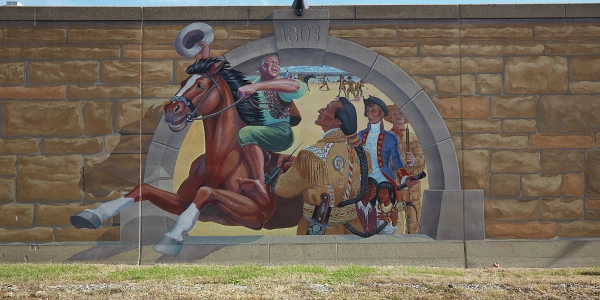
Cape Girardeau's Murals
The Mississippi Mural Tales cover 18,000 square feet of the fifteen foot high floodwall that protects the city. Twenty-four panels that tell the story of the Mississippi and Cape Girardeau were painted by Thomas Melvin and staff in looking through the glass style. It was dedicated in 2005.
The panels reflect various themes: Planning a City, Lewis and Clark, The Louisiana Purchase, Missouri Statehood, the Trail of Tears, the Civil War (2), St. Vincent's Young Ladies Academy, River Commerce, Taft's Visit, the Great Fire, the Big Freeze, the Three Cape Girardeau's, Riverboat Jazz, the Big Flood, River Industry, the Great Wall, Riverfest. No, there is not a mention of the 1846 meteorite.
And on the river side of the levee is another mural in Riverfront park. It depicts the heros of Missouri. The park is not always available, depending on the water level. It also has a walk/bike trail, terraced seating for an amphitheater effect, and is the docking site for paddle boat tours. That's alot to fit into its small size, 1.5 acres, but it does it well.
Image above: Riverwall mural of the Lewis and Clark Expedition, 2020, Carol M. Highsmith. Courtesy Library of Congress. Below: Painted rock mural of Cape Girardeau Confederate infantry, 140th, 2020, Carol M. Highsmith. Courtesy Library of Congress.


Other Attractions
Glenn House - Built in 1883, the Glenn House is a historic museum lived in by the David Glenn family until 1915. It is a Victorian masterpiece, open seasonally for visitation or events.
Katey O'Farrell's Publick House Tavern - A newer treat from an Irish immigrant family who made their way to Missouri through Virginia and Kentucky. It's an Irish pub. Feel at home after a long day taking in other Cape Girardeau sites.
St. Vincent's College - Cape Vincent's college was established on October 10, 1838 as a Male Academy, them rising over the next decade to be both a college for men and seminary for Catholic priests. By the time of the Civil War, the intent was to focus purely on educating men for the priesthood, but plans were altered due to the war. It would educate students until 1979 when the campus was sold to the State of Missouri, who now use it as the River Campus of the Southeast Missouri State University, which focuses on the visual and performing arts.
Academic Hall - Built in the center of Cape Girardeau in 1906, the building is now used by Southeast Missouri State University as administrative offices, an auditorium, and some classrooms. Its interior includes historic light fixtures used at the St. Louis World's Fair of 1904.
Photo above: St. Vincent's College and Seminary, now part of the Southwest Missouri State Campus, unknown date, Historic American Buildings Survey. Courtesy Library of Congress.

T-Shirts and Gifts from the official souvenirs of Americasbesthistory.com.
About
America's Best History where we take a look at the timeline of American History and the historic sites and national parks that hold that history within their lands.
Photos courtesy of the Library of Congress, National Archives, National Park Service, americasbesthistory.com and its licensors.
- Contact Us
- About
- © 2025 Americasbesthistory.com.
Template by w3layouts.

